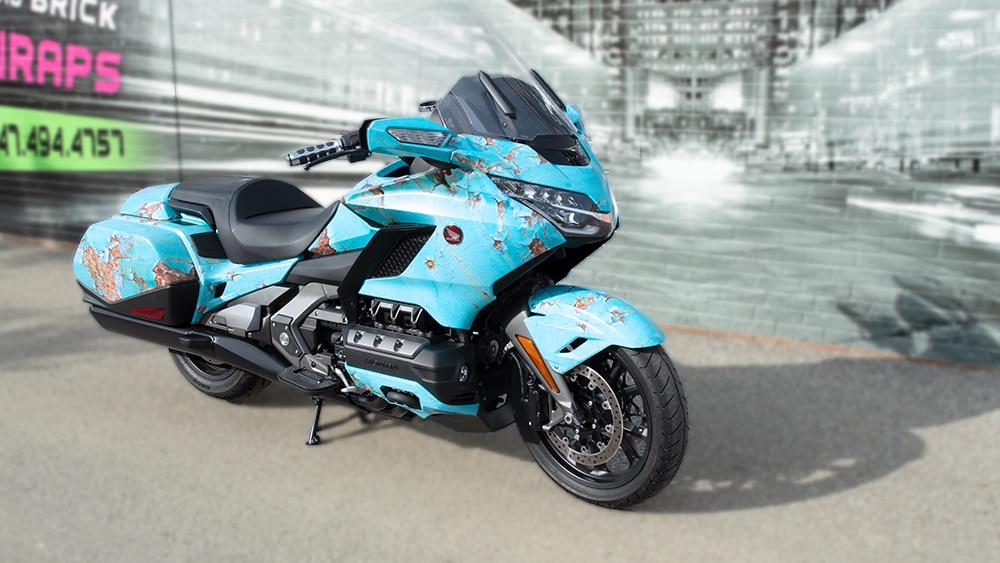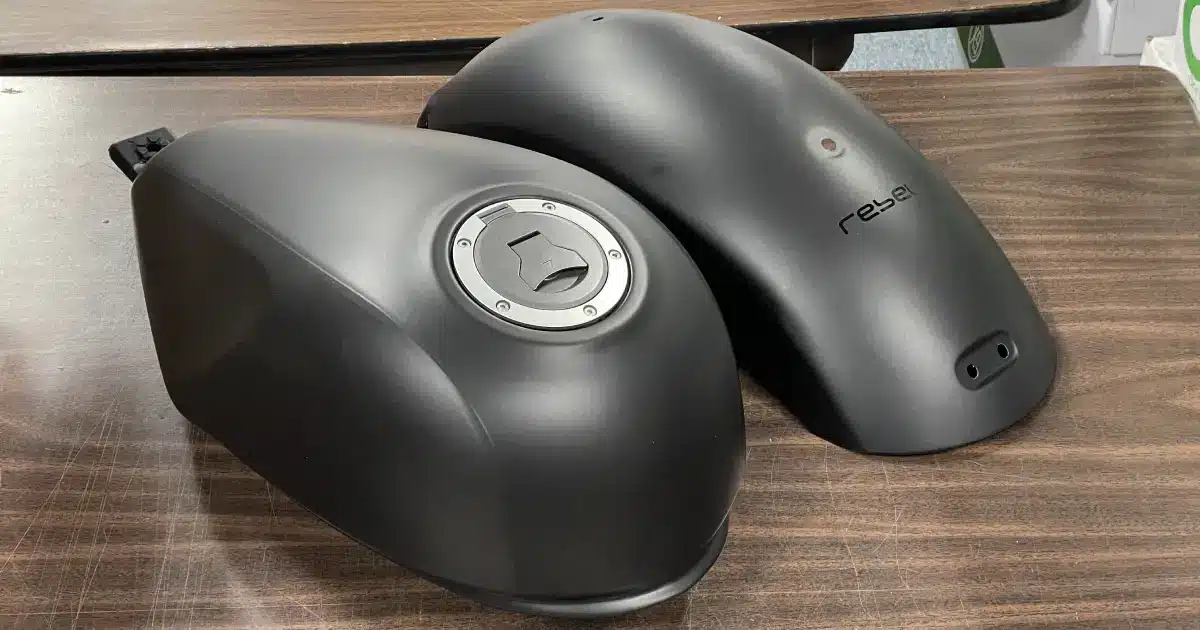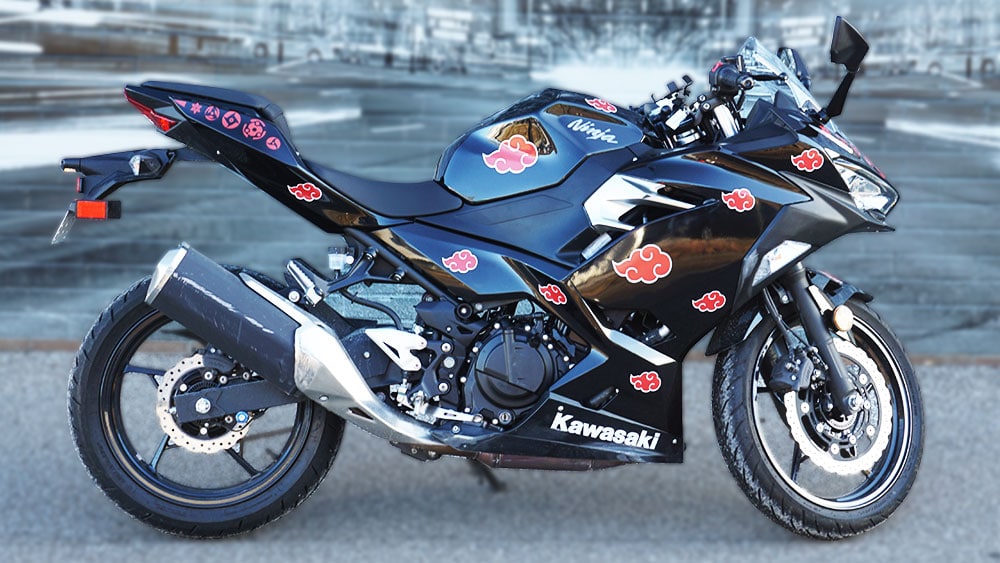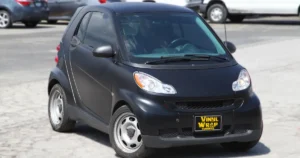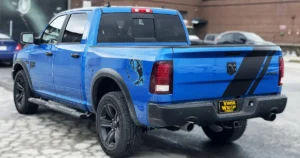If you’re a motorcycle enthusiast, you’re probably always on the lookout for ways to customize your bike and make it stand out from the crowd. One increasingly popular option for doing so is through motorcycle wraps.
A motorcycle wrap is a vinyl film that is applied to the surface of a motorcycle, creating a customized look and providing additional protection to the original paint job. There are many reasons why motorcycle wraps are becoming more popular among bikers. Here are some of the key reasons:
- Customization: Motorcycle wraps allow for a level of customization that was once only possible with expensive custom paint jobs. With a wrap, you can choose from a wide range of colours, designs, and textures to create a look that is uniquely yours.
- Protection: A motorcycle wrap provides an extra layer of protection to the paint job of your bike, shielding it from scratches, dings, and other damage. This is especially important if you ride your bike frequently or in harsh weather conditions.
- Cost-effectiveness: While custom paint jobs can be extremely expensive, motorcycle wraps are a more cost-effective way to achieve a custom look for your bike. Additionally, if you ever want to change the look of your bike, a wrap can be easily removed and replaced with a new design, whereas repainting a motorcycle can be a time-consuming and expensive process.
- Durability: Motorcycle wraps are designed to be durable and long-lasting, with many high-quality vinyl films lasting up to five years or more. This means that your custom design will stay looking great for years to come.
- Increased resale value: If you’re thinking about selling your motorcycle in the future, a custom wrap can actually increase its resale value. A well-maintained wrap can protect the original paint job of your bike, making it more appealing to potential buyers.
1. Types of Motorcycle Wraps
When it comes to motorcycle wraps, there are several different types to choose from. Each type has its own benefits and drawbacks, depending on your specific needs and preferences. Here are the main types of motorcycle wraps:
- Full Wraps: A full wrap covers the entire surface of the motorcycle, including the tank, fenders, fairings, and other parts. This is the most comprehensive option, providing complete coverage and customization. Full wraps can be a great choice if you’re looking for a total transformation of your bike’s appearance or if you want to protect the original paint job entirely.
Full Wrap – Motorcycle – Honda Gold Wing Rust - Partial Wraps: A partial wrap covers only a portion of the motorcycle’s surface, typically the tank or the fairings. This is a more cost-effective option than a full wrap, while still providing a significant level of customization and protection. Partial wraps can be a great choice if you want to add some visual interest to your bike without completely changing its appearance.
Honda Rebel – Tank Wrap - Decals and Graphics: Decals and graphics are a popular option for adding a customized look to your motorcycle without the expense and time commitment of a full or partial wrap. Decals are pre-designed vinyl stickers that can be applied to the surface of the bike, while graphics are more complex designs that may be custom-created for your specific bike. Decals and graphics can be applied to any part of the motorcycle and can range from subtle accents to bold designs.
Naruto Themed Motorcycle Decals – Kawasaki Ninja 400 - Custom Designs: With a custom design, you can create a completely unique look for your motorcycle. This option is typically more expensive than pre-designed options, but it allows for complete creative freedom. Custom designs can incorporate any colours, patterns, or imagery you desire, making them a great choice if you have a specific vision in mind for your bike’s appearance.
There are many different types of motorcycle wraps to choose from, each with its own benefits and drawbacks. When choosing a wrap, consider your budget, the level of customization and protection you want, and your personal style preferences.
2. How to Choose The Right Motorcycle Wrap
Choosing the right motorcycle wrap can be a daunting task, with so many options available. Here are some considerations, tips, and factors to keep in mind when selecting the best wrap for your bike:
A. Considerations When Choosing a Wrap:
- Purpose: Determine why you want to wrap your motorcycle. Are you looking for protection, customization, or both?
- Material: Choose a high-quality vinyl wrap that is designed for outdoor use and is resistant to fading, cracking, and peeling.
- Design: Consider the colours, patterns, and graphics you want for your bike. Do you want a subtle accent or a bold design?
- Brand and Installer: Choose a reputable brand and installer to ensure that your wrap is properly installed and will last for years.
B. Tips for Selecting the Best Wrap for Your Bike:
- Samples: Request samples of the vinyl material and designs to get a better idea of how they will look on your motorcycle.
- Reviews: Check reviews of the brand and installer you are considering to ensure that they have a good reputation.
- Compatibility: Make sure the wrap is compatible with the surface of your motorcycle, such as the material of the fairings or the tank.
- Maintenance: Consider the maintenance requirements of the wrap, such as how to clean it and how often it needs to be maintained.
C. Factors That Can Affect the Cost of a Wrap:
- Size and Coverage: The size and coverage of the wrap will affect the cost. A full wrap will be more expensive than a partial wrap.
- The complexity of Design: The complexity of the design will also affect the cost, with custom designs being more expensive than pre-designed options.
- Brand and Installer: The brand and installer you choose will affect the cost, with more reputable brands and installers charging more for their services.
- Location: The location of the installer can also affect the cost, with prices varying depending on the region.
When choosing the right motorcycle wrap, consider the purpose, material, design, brand and installer. It’s also important to request samples, check reviews, ensure compatibility, and consider maintenance requirements. Finally, factors such as size and coverage, the complexity of design, brand and installer, and location can all affect the cost of a wrap.
3. Motorcycle Wrap Installation Process
The installation of a motorcycle wrap requires precision, patience, and attention to detail to ensure a flawless and long-lasting result. Here are the main steps of the motorcycle wrap installation process:
A. Preparation of the Motorcycle:
- Clean the surface: The surface of the motorcycle must be thoroughly cleaned and dried to ensure that there is no dust, dirt, or debris that could interfere with the adhesion of the vinyl wrap.
- Removal of parts: In some cases, certain parts of the motorcycle may need to be removed to ensure a proper fit and alignment of the wrap.
- Masking: Parts of the motorcycle that will not be wrapped, such as the handlebars or wheels, will be masked off to protect them during the installation process.
B. Application of the Wrap:
- Measurements: The wrap will be measured and cut to fit the specific dimensions of the motorcycle.
- Application: The wrap will be applied to the motorcycle using a squeegee, starting from the center and working outward to ensure a smooth and even application.
- Stretching: The wrap may need to be stretched or heat-formed in certain areas to ensure proper fit and alignment.
C. Post-Installation Care:
- Trimming: Once the wrap is applied, any excess vinyl will be trimmed away.
- Inspection: The installer will inspect the wrap to ensure that there are no bubbles, wrinkles, or other imperfections.
- Initial Washing Instructions: The motorcycle should not be washed or exposed to rain or other moisture for at least 24-48 hours after the wrap is installed to ensure that the adhesive has fully cured. After that, the motorcycle can be washed and maintained as usual.
The motorcycle wrap installation process requires careful preparation, precise measurements, and skilled application techniques. Following the post-installation care instructions will help ensure that your wrap lasts for years to come. It’s important to have a professional installer who has experience in wrapping motorcycles to ensure the best possible outcome.
4. Maintenance of Motorcycle Wrap
Proper maintenance is key to ensuring that your motorcycle wrap looks great and lasts as long as possible. Here are some tips and guidelines for maintaining your motorcycle wrap:
A. How to Keep Your Motorcycle Wrap Looking New:
- Avoid scratches and dings: Be mindful of where you park and avoid contact with sharp objects or surfaces that could scratch or damage the vinyl.
- Regular cleaning: Regular cleaning is essential to remove dirt, dust, and other debris that can accumulate on the surface of the wrap and cause it to look dull or faded.
- Avoid harsh chemicals: Avoid using harsh chemicals or abrasive cleaners that could damage or discolour the vinyl. Use only products recommended by the manufacturer or installer.
B. Products and Tools to Use:
Soft cloth or sponge: Use a soft cloth or sponge to clean the surface of the wrap.
Mild soap: Use a mild soap or detergent that is safe for use on vinyl.
Water: Use water to rinse away dirt and soap residue.
C. Cleaning and Maintenance Schedule:
- Frequency: Depending on the amount of use and exposure to the elements, you may need to clean your motorcycle wrap every week or every few weeks.
- Cleaning Process: Begin by rinsing the surface with water to remove any loose dirt or debris. Then, use a mild soap and soft cloth or sponge to clean the surface of the wrap, being careful not to scrub too hard or use harsh chemicals. Rinse thoroughly with water and dry with a soft cloth or let it air dry.
- Additional Maintenance: If you notice any small scratches or scuffs on the surface of the wrap, you can use a vinyl repair kit to touch up the affected areas.
To keep your motorcycle wrap looking new, avoid scratches and dings, use only recommended products and tools, and follow a regular cleaning and maintenance schedule. By taking proper care of your motorcycle wrap, you can extend its lifespan and ensure that it looks great for years to come.
5. Removing Motorcycle Wraps
If you need to remove a motorcycle wrap for any reason, whether it is to change the design or to sell the bike, it’s important to do so carefully to avoid damaging the underlying paint or finish. Here are some tips and guidelines for removing a motorcycle wrap:
A. How to Remove a Motorcycle Wrap:
Heat the vinyl: Using a heat gun or other heat source, gently heat the surface of the vinyl wrap to soften the adhesive and make it easier to remove.
Peel off the wrap: Starting from one edge or corner, slowly and carefully peel off the vinyl wrap, being careful not to damage the underlying paint or finish.
Remove any adhesive residue: Once the vinyl wrap is removed, any remaining adhesive residue can be removed using a mild solvent, such as isopropyl alcohol or adhesive remover. Be sure to test the solvent on a small, inconspicuous area first to ensure that it does not damage the paint or finish.
B. Tips for a Successful Removal:
- Use a heat gun or other heat source to soften the adhesive and make it easier to remove.
- Work slowly and carefully to avoid damaging the underlying paint or finish.
- Use a mild solvent to remove any remaining adhesive residue.
C. Pros and Cons of Removing a Wrap:
- Pros: Removing a motorcycle wrap can allow you to change the design or colour of your bike without having to paint it, which can be expensive and time-consuming. Additionally, removing the wrap can restore the original paint or finish to its original condition, which can increase the resale value of the bike.
- Cons: Removing a motorcycle wrap can be time-consuming and labour-intensive, especially if the wrap has been on the bike for a long time and the adhesive is particularly strong. Additionally, there is a risk of damaging the underlying paint or finish if the removal process is not done carefully and correctly.
If you need to remove a motorcycle wrap, use a heat source to soften the adhesive, work slowly and carefully to avoid damaging the underlying paint or finish, and use a mild solvent to remove any remaining adhesive residue. While there are pros and cons to removing a wrap, it can be a good option if you want to change the design or colour of your bike without having to paint it.
6. FAQs about Motorcycle Wraps
What is a motorcycle wrap?
A motorcycle wrap is a vinyl film that can be applied to the body of a motorcycle to change its colour, add graphics or designs, and protect the original paint or finish.
How long does a motorcycle wrap last?
The lifespan of a motorcycle wrap depends on various factors such as the type of wrap, installation quality, and maintenance. High-quality wraps can last for up to five years or longer with proper care.
What materials do you use?
We only use premium quality vinyl material by Avery Dennison, 3M and Hexis.
Can a motorcycle wrap be removed?
Yes, motorcycle wraps can be removed without damaging the original paint or finish of the bike. However, it’s important to remove the wrap carefully and correctly to avoid causing any damage.
Can a motorcycle wrap be washed?
Yes, a motorcycle wrap can be washed, but it’s important to use the right cleaning products and techniques to avoid damaging the vinyl film. Avoid using harsh chemicals, abrasive cleaners, or pressure washers.
How much does a motorcycle wrap cost?
The cost of a motorcycle wrap varies depending on various factors such as the size of the bike, the type of wrap, and the complexity of the design. A full wrap can cost anywhere from a few hundred to several thousand dollars.
Can I install a motorcycle wrap myself?
While it’s possible to install a motorcycle wrap yourself, it’s generally recommended to have it done by a professional installer to ensure a high-quality result. DIY installation can be challenging and may result in bubbles, wrinkles, or other issues.
What types of designs can be applied to a motorcycle wrap?
Motorcycle wraps can feature a wide range of designs, including solid colours, metallic finishes, matte finishes, graphics, and custom designs. The possibilities are virtually endless.
Will a motorcycle wrap damage the original paint or finish?
No, a motorcycle wrap should not damage the original paint or finish of the bike if it is installed and removed correctly. In fact, it can help protect the underlying paint or finish from damage caused by the elements or regular wear and tear.
Can a motorcycle wrap be repaired if it is damaged?
In some cases, a damaged motorcycle wrap can be repaired. However, it’s important to work with a professional installer to ensure that the repair is done correctly and does not compromise the overall quality of the wrap.
Will a motorcycle wrap affect the resale value of the bike?
In general, a well-installed and maintained motorcycle wrap should not have a significant impact on the resale value of the bike. In fact, it can potentially increase the value by protecting the original paint or finish and making the bike stand out from the crowd.
Conclusion
In conclusion, motorcycle wraps are a great way to customize and protect your bike. They offer a range of benefits, including:
- Customization: Motorcycle wraps come in a wide variety of colours, designs, and patterns, making it easy to create a unique and personalized look for your bike.
- Protection: Wraps can help protect your bike’s paint or finish from scratches, chips, and other damage caused by the elements or regular wear and tear.
- Affordability: Compared to other custom paint or finish options, motorcycle wraps are relatively affordable and can be a cost-effective way to transform the look of your bike.
When choosing and maintaining a motorcycle wrap, it’s important to consider factors such as the type of wrap, cost, and installation process, as well as proper cleaning and maintenance techniques. By following these guidelines, you can ensure that your motorcycle wrap looks great and lasts as long as possible.
If you’re considering a motorcycle wrap for your bike, we encourage you to do your research and work with a reputable installer to ensure a high-quality result. With the right wrap, you can give your bike a fresh new look and protect it from damage for years to come.
Learn more on our Motorcycle Vinyl Wraps Page.
Get an Estimate
- Fill out an online form
- Call us at 416-746-1381
- Get Directions (Opens in new tab or maps app)


